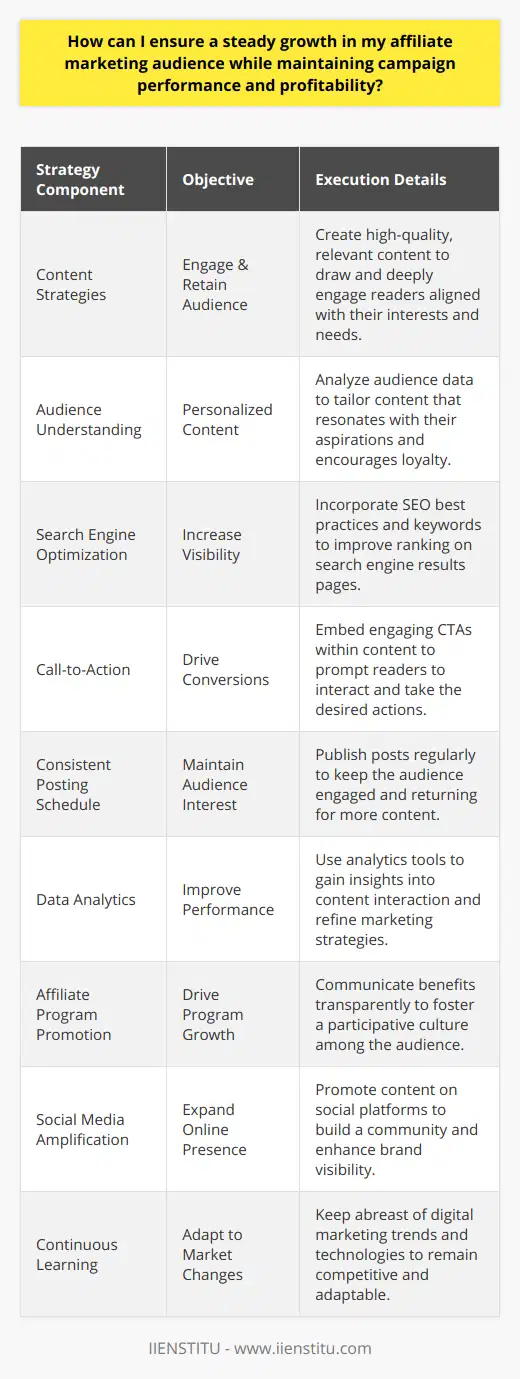
Are you looking to start a successful affiliate marketing campaign? If so, you're in the right place. In this blog post, we'll give you tips on how to get started.
We'll also provide information on what you need to do to make your campaign successful. So, read on for helpful advice, whether you're a beginner or an experienced marketer!
There are many examples of businesses succeeding in affiliate marketing. One notable example is Amazon's affiliate program, which has helped the company become one of the world's largest retailers. Other companies that have been successful with affiliate marketing include Clickbank, Commission Junction, and Rakuten.
What are these companies doing right? And how can you launch a successful affiliate marketing campaign of your own? Here are some tips to get you started:
How to get started with affiliate marketing
Affiliate marketing might be the right option if you're looking for a way to make money online. It's a great way to earn passive income, and there are several things you can do to get started.
There are a few key things to keep in mind when launching an affiliate marketing campaign:
Choose the right affiliate program.
When it comes to affiliate marketing, choosing the right affiliate program is essential. Not all programs are created equal, and the terms and conditions vary greatly. For example, some programs offer higher commissions than others, while some have better products or services to promote. Therefore, it's essential to research and choose an affiliate program that you believe in and know will be profitable.
The last thing you want is to promote a product or service that isn't worth your time or doesn't convert well. By taking the time to choose the right affiliate program, you'll be setting yourself up for success from the start.
Promote products that you believe in.
It's important to only promote products that you believe in and that you would recommend to a friend or family member. If you're promoting a product just because it pays well, your customers will likely be able to tell. And if they can tell that you're not genuinely interested in the product, they're less likely to make a purchase. It's important to be passionate about the products or services you promote, as this will come through in your marketing materials and help to convert potential customers.
Create high-quality content.
When it comes to affiliate marketing, content is king. You must create informative, interesting, and relevant content for your target audience. If your content is dull or irrelevant, people are less likely to read it, let alone make a purchase based on your recommendation. Invest time and effort into creating high-quality content, and your affiliate marketing campaign will be more successful.
Use effective marketing techniques.
There are a variety of marketing techniques that you can use to promote your affiliate products or services. It's important to find the ones that work best for you and your business. Some effective marketing techniques include social media marketing, email marketing, pay-per-click advertising, and search engine optimization. Experiment with different marketing techniques to see which generates the most leads and sales for your business.
Track your results.
It's important to track your results so that you know what's working and what isn't. This way, you can change your affiliate marketing campaign as needed. You can track various metrics, such as click-through rate, conversion rate, and average order value. By tracking your results, you'll be able to fine-tune your affiliate marketing campaign for maximum success.
But do all these suggestions work? There are some risks involved. If you end up promoting affiliate products that are low quality or that don't convert well, you could end up losing money. But if you take the time to choose the right affiliate program and promote products you believe in, you'll be on your way to a successful affiliate marketing campaign.
The best example of this is when affiliate marketers use email marketing. First, they carefully choose affiliate products they believe in and think will be valuable to their subscribers. Then, they create high-quality content that promotes these products.
And finally, they track their results to fine-tune their affiliate marketing campaign for maximum success. Why? Because affiliate marketing can be very profitable if it's done correctly.
A business that failed with affiliate marketing is JC Penney.
The affiliate program was poorly managed, and the affiliate marketers were not properly compensated. As a result, many affiliate marketers stopped promoting JCPenney products. This led to a significant drop in sales for the company.
In the early 2010s, JC Penney was one of the most popular retailers in the United States. However, in 2012, the company made a fateful decision that would lead to its downfall: it implemented an affiliate marketing program. Affiliate marketing is a performance-based marketing technique in which businesses compensate third-party publishers for driving traffic to their websites.
The program was poorly managed, and the affiliate marketers were not properly compensated. As a result, many affiliate marketers stopped promoting JCPenney products. This led to a significant drop in sales for the company.
In 2013, JCPenney announced that it was discontinuing its affiliate program. Unfortunately, this was too little too late, and the damage had been done. The company has never recovered, and its once-loyal customer base has largely deserted it.
JC Penney's experience is a cautionary tale for businesses considering implementing an affiliate marketing program. However, when done correctly, affiliate marketing can be a great way to drive traffic to your website and generate sales.
However, if not managed properly, it can lead to disaster. So, before starting an affiliate program, ensure you have the proper infrastructure to support it. Otherwise, you may find yourself following in JC Penney's footsteps.
Launching a successful affiliate marketing campaign takes time, effort, and planning. But with the right approach, you can see great results.
By focusing on building relationships with your affiliates and creating valuable content, you'll be well on your way to seeing success. Have you launched an affiliate marketing campaign? What tips would you add?
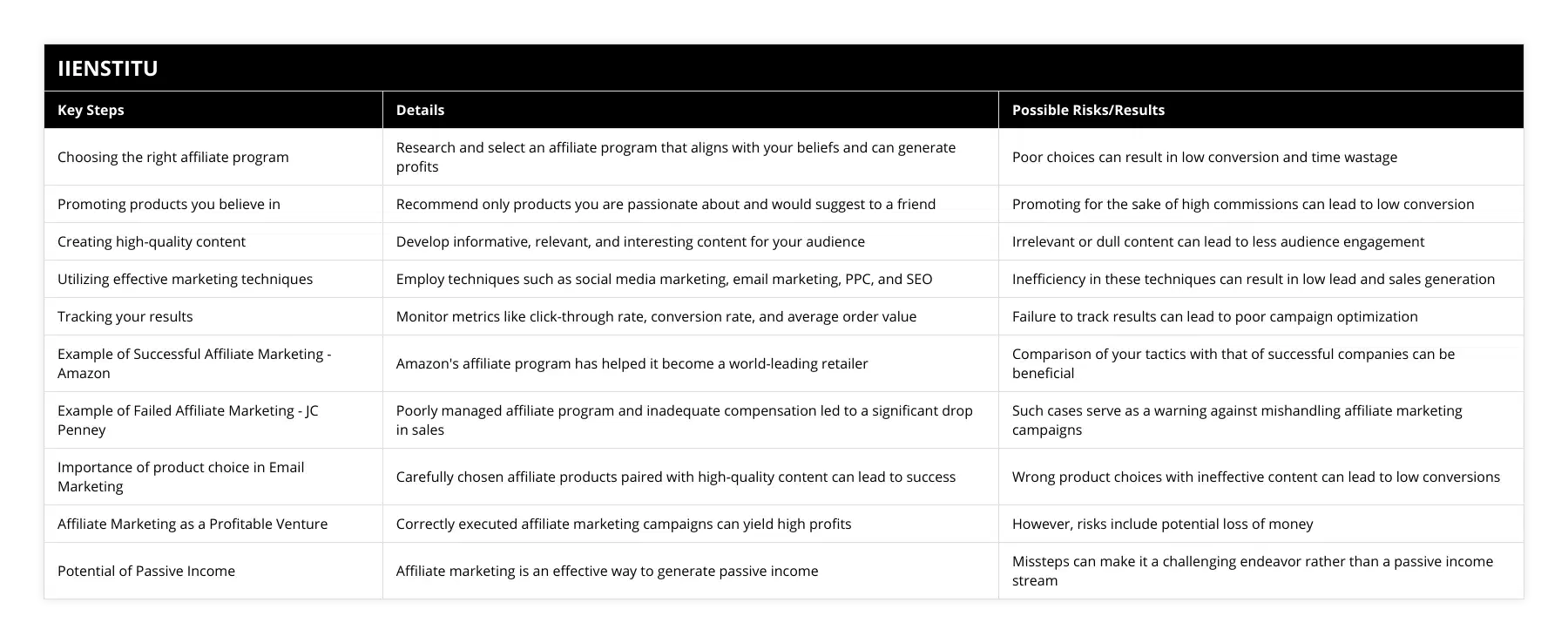
Frequently Asked Questions
How do you create compelling content that will attract affiliates?
To create compelling content that will attract affiliates, you need to focus on providing value. Write articles, blog posts, and social media updates that offer value to your audience - helpful information, an entertaining story, or a unique perspective. When your content is truly valuable, people will be more likely to share it with their networks. And when it comes to affiliates, the bigger your reach, the better.
In addition to valuing quality over quantity, you should also ensure that your content is well-written and well-designed. First impressions matter, so take the time to create something visually appealing and easy to read. If you hook your reader from the first sentence, you're more likely to keep them engaged through to the end. By following these tips, you can create content that's not only valuable but also irresistible - perfect for attracting affiliates and driving traffic to your site.
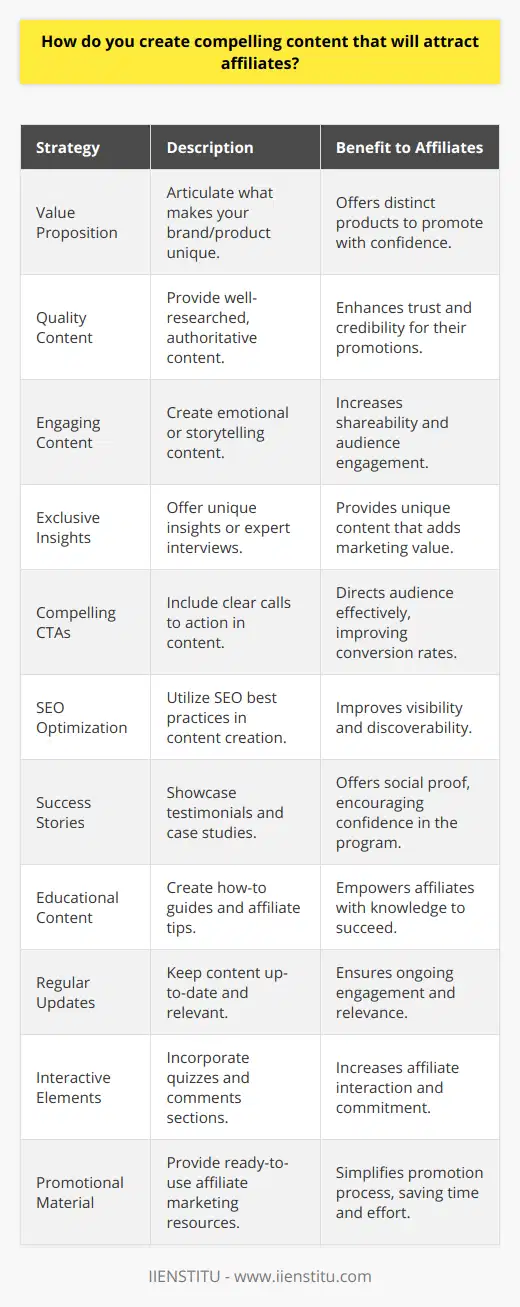
What are some of the most effective ways to track affiliate activity?
As the use of affiliate marketing continues to grow, so does the need for ways to track affiliate activity. Several different methods can be used to track affiliates, and the most effective approach will vary depending on the size and structure of the affiliate program. For small programs, manually tracking activity may be sufficient.
This can be done by keeping a spreadsheet record of clicks and sales or using simple tracking software. For larger programs, however, more sophisticated tracking methods are necessary. These can include cookies, pixel tags, and log files. By understanding the different options and choosing the right approach for their program, affiliate marketers can ensure that they accurately track all activity.
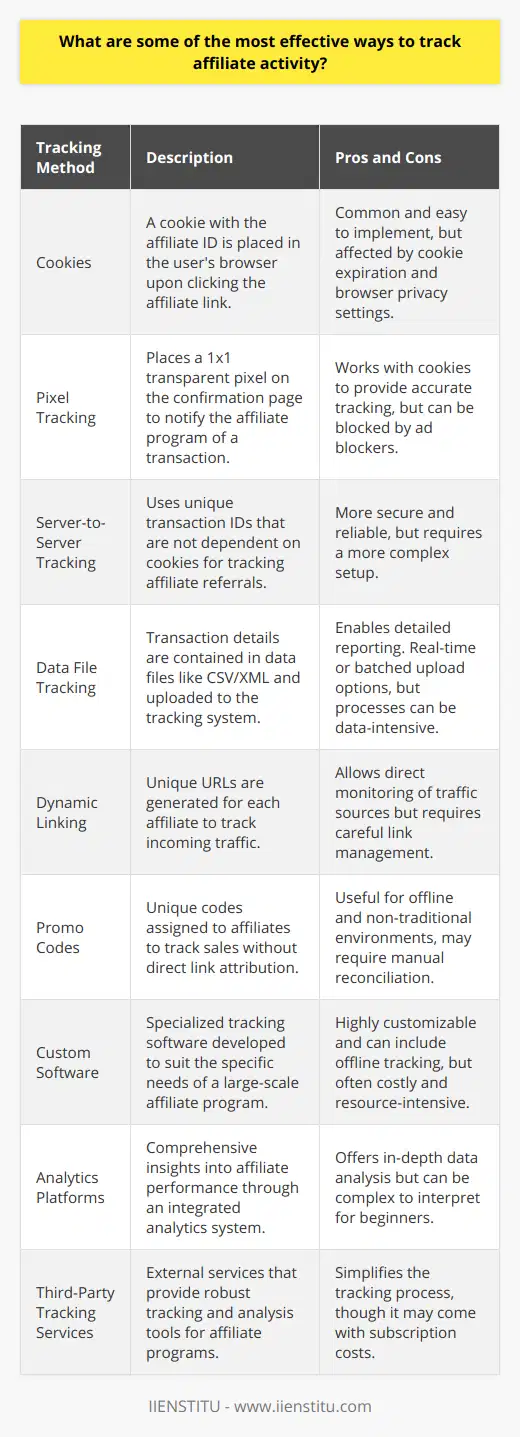
What are the biggest mistakes people make when launching an affiliate marketing campaign?
The biggest mistake people make when launching an affiliate marketing campaign is failing to do their research. Before starting any marketing campaign, it's important to understand your target audience and what type of content they are most likely to engage with. If you don't take the time to understand your audience, you'll have a hard time creating content that resonates with them. Additionally, you need to set realistic expectations for your campaign.
Building an audience and generating organic traffic takes time, so don't expect immediate results. Finally, ensure you are tracking your progress to adjust your strategy as needed. You can launch a successful affiliate marketing campaign with careful planning and execution.
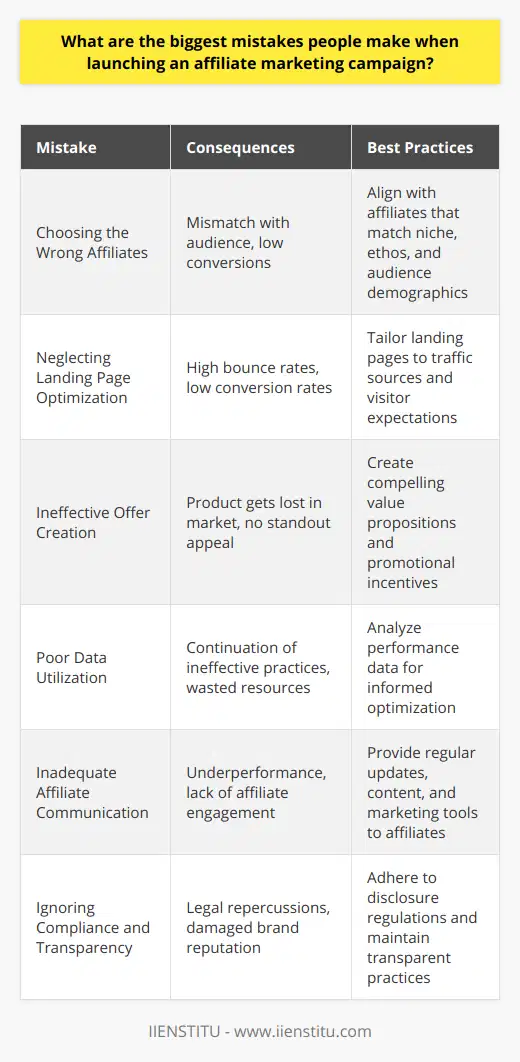
How do I grow my affiliate marketing audience?
Understanding Affiliate Marketing Audiences
To grow an affiliate marketing audience, it is essential to understand the target audience's characteristics and preferences. People are drawn to content that aligns with their interests and needs; therefore, beginning with audience analysis will be helpful in designing an attractive and relevant marketing strategy.
Creating Consumer-Centric Content
Developing a content strategy based on the target audience's preferences and pain points is crucial. This includes creating high-quality, informative, and engaging content that will attract and retain the audience's attention. An approach of providing value through blog posts, articles, and multimedia formats generates trust and positions the marketer as an authority.
Leveraging Social Media Platforms
Social media platforms provide a great opportunity to expand affiliate marketing audiences. By utilizing these platforms, one can develop strategic partnerships and collaborations with influencers who have an established following. Sharing and promoting affiliate-related content on social media will increase visibility, capture a wider audience, and encourage engagement.
Search Engine Optimization
Implementing SEO best practices in the blog post would ensure a better ranking on search engines, resulting in increased organic traffic. This entails optimizing blog content and website structure, focusing on relevant keywords, and generating valuable backlinks from reputable sources. These efforts will significantly contribute to growing the affiliate marketing audience.
Utilizing Email Marketing
Building an email list and sending out periodic newsletters is another viable strategy to increase affiliate marketing reach. Through tailored email marketing campaigns, the marketer can personalize content, announce promotions, and continually engage with the subscribers. This will ensure a steady flow of affiliate conversions and audience growth.
Monitoring and Improving
Regularly monitoring the performance of the blog post and analyzing affiliate marketing results allows for identifying areas for improvement. Strategies can be adapted according to engagement statistics, click-through-rates, and conversion rates. Continuously refining the approach is vital to achieve the desired growth in the affiliate marketing audience.
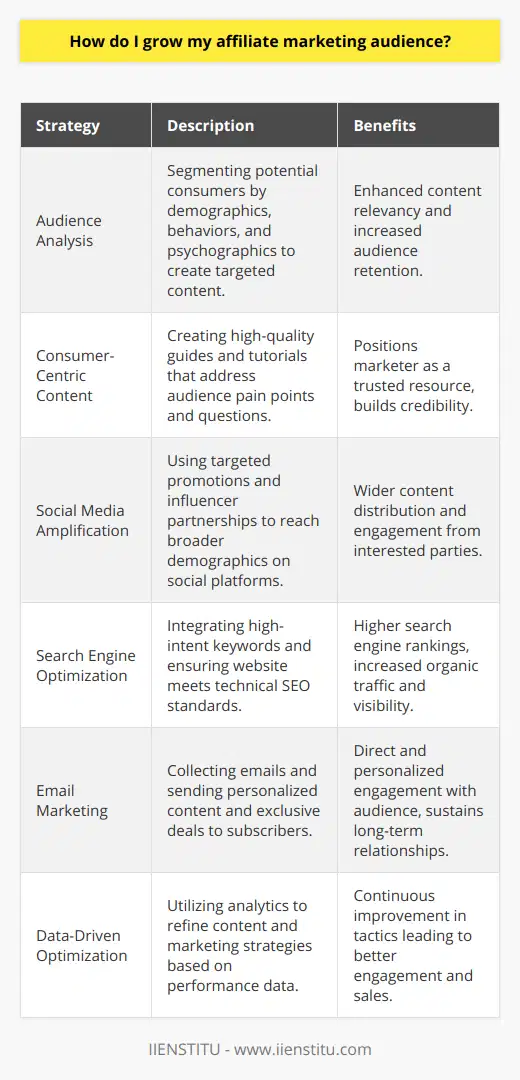
What strategies should I implement to efficiently run an affiliate marketing ad campaign?
Selecting the Right Affiliate Program
To efficiently run an affiliate marketing ad campaign, it is crucial to choose an affiliate program that aligns with your niche and target audience. This will ensure that the products you promote are relevant to your audience, thus increasing your chances of driving conversions.
Creating High-Quality Content
High-quality and engaging content should be at the core of your affiliate marketing strategy. By providing valuable content that resonates with your audience, you can pre-sell the affiliate products and increase your conversion rate. This could include blog posts, videos, or other content that includes informative and persuasive information about the products you are promoting.
Utilizing SEO and Keyword Research
Effective search engine optimization (SEO) and keyword research are integral to driving organic traffic to your blog or website. By optimizing your content for relevant keywords, you can increase its visibility on search engine result pages, attracting a larger audience and improving the probability of converting visitors into customers.
Leveraging Social Media and Influencers
Social media platforms and influencers can significantly enhance the reach of your affiliate marketing campaign. By collaborating with influencers in your niche or leveraging popular social media channels like Facebook, Instagram, and Twitter, you can elevate your affiliate marketing efforts and increase your exposure to potential customers.
Analyzing and Optimizing Campaign Performance
Monitoring and analyzing your affiliate marketing campaign's performance is essential to identify areas for improvement and optimize your strategy. This could involve tracking metrics such as click-through rates, conversion rates, and return on investment (ROI), and adjusting your content or marketing tactics accordingly to maximize results.
Employing Retargeting Techniques
Retargeting techniques can help you re-engage with visitors who did not convert during their initial visit to your blog or website. By using retargeting ads or email marketing campaigns, you can remind potential customers of the products they previously showed interest in and increase the likelihood of conversion.
In conclusion, an efficient affiliate marketing ad campaign involves selecting the right affiliate program, creating high-quality content, leveraging SEO and keyword research, utilizing social media and influencers, and continually analyzing and optimizing your campaign performance. By implementing these strategies, you can effectively promote affiliate products and maximize your revenue potential.

How can I optimize my affiliate marketing efforts to ensure long-term success?
Understanding Affiliate Marketing
To optimize affiliate marketing efforts for long-term success, it is essential to first comprehend its fundamentals. Affiliate marketing enables online content creators to earn a commission by promoting other companies' products or services. By developing a deep understanding of one's target audience and industry niches, the marketing strategy can be personalized to appeal to potential customers effectively.
Building Trust and Credibility
Gaining the trust and credibility of the target audience is a crucial factor in optimizing affiliate marketing performance. Content creators should prioritize providing valuable, genuine, and relevant information that addresses the needs and preferences of their audience. Transparently disclosing affiliate relationships and recommending products ethically further contribute to building a solid reputation, leading to increased conversion rates.
Selecting the Right Products
The strategic selection of appropriate products significantly impacts the effectiveness of affiliate marketing efforts. Choosing high-quality products that align with the content creator's unique expertise and the audience's preferences result in higher consumer satisfaction and better long-term returns. Additionally, partnering with reputable and well-established brands enhances credibility and the possibility of repeat customers.
Optimizing Conversion Rates
Optimizing conversion rates requires a multi-faceted approach that includes persuasive copywriting, persuasive calls-to-action, and targeted landing pages. Split-testing different elements of the marketing campaign, such as headlines, images, and link placements, allows identification of the most effective strategies. Moreover, utilizing analytics tools helps to assess performance and make data-driven decisions that steer the marketing approach in the right direction.
Investing in Continuous Learning
Finally, investing time and resources in continuous learning and staying informed on the latest trends and best practices in affiliate marketing can significantly improve overall efforts. Effective marketers actively participate in online forums, attend industry conferences, read blogs, and engage in networking opportunities. Continuously acquiring new skills and knowledge keeps marketers at the forefront of the industry, fostering agility, adaptability, and long-term success.
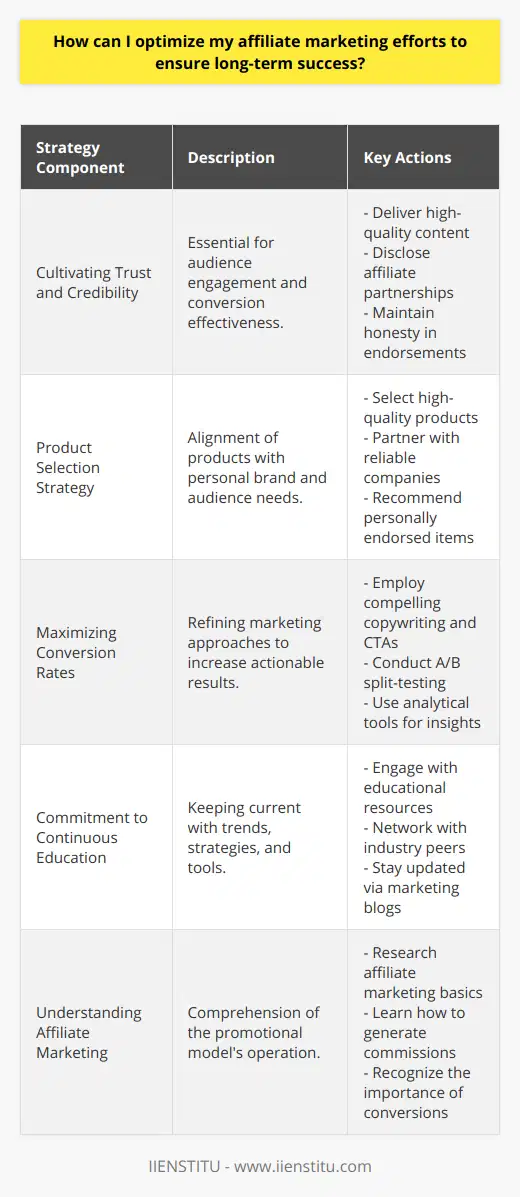
How do I run a successful affiliate campaign?
Understanding the Fundamentals
To run a successful affiliate campaign, one must begin by comprehending the essential elements that contribute to its effectiveness. This involves recognizing the primary stakeholders involved, such as the affiliates, customers, and merchants or advertisers.
Selecting the Right Affiliates
A crucial step in ensuring success is the careful selection of affiliates. This includes partnering with people or businesses that complement the products or services being promoted, enabling a mutual exchange of value through the promotion of relevant and useful content to their audience.
Establishing Clear Goals
Defining and communicating precise goals for the affiliate campaign is indispensable. Examples of common objectives include increasing brand awareness, generating leads, and boosting sales. By having a clear understanding of the desired outcomes, one can tailor strategies and resources accordingly.
Determining Appropriate Commission Rates
Formulating a commission structure that adequately incentivizes affiliates is essential for fostering productive relationships. In this regard, businesses should conduct market research to understand competitive rates and develop a system that balances fairness and profitability.
Investing in High-Quality Content
One significant element of an effective affiliate campaign is the creation and distribution of valuable content. Sharing informative, engaging, and persuasive materials will not only encourage potential customers to engage with the brand but also enhance credibility and trustworthiness.
Employing Tracking and Reporting Tools
To gauge the effectiveness of an affiliate campaign, it is vital to employ tracking and reporting tools. By monitoring key performance indicators (KPIs) such as clicks, conversions, and sales, businesses can make data-driven decisions to optimize and improve their strategy.
Offering Continuous Support
Lastly, businesses should ensure open communication and support for their affiliates. This includes providing access to promotional materials, the latest product information, and ongoing training opportunities. By nurturing these relationships, businesses can improve the overall performance of their affiliate campaigns.
In conclusion, running a successful affiliate campaign necessitates a comprehensive understanding of its fundamental principles, coupled with the implementation of strategic measures such as selecting the right affiliates, establishing clear goals, and offering continuous support. By adhering to best practices, businesses can work towards realizing the full potential of their affiliate marketing efforts.
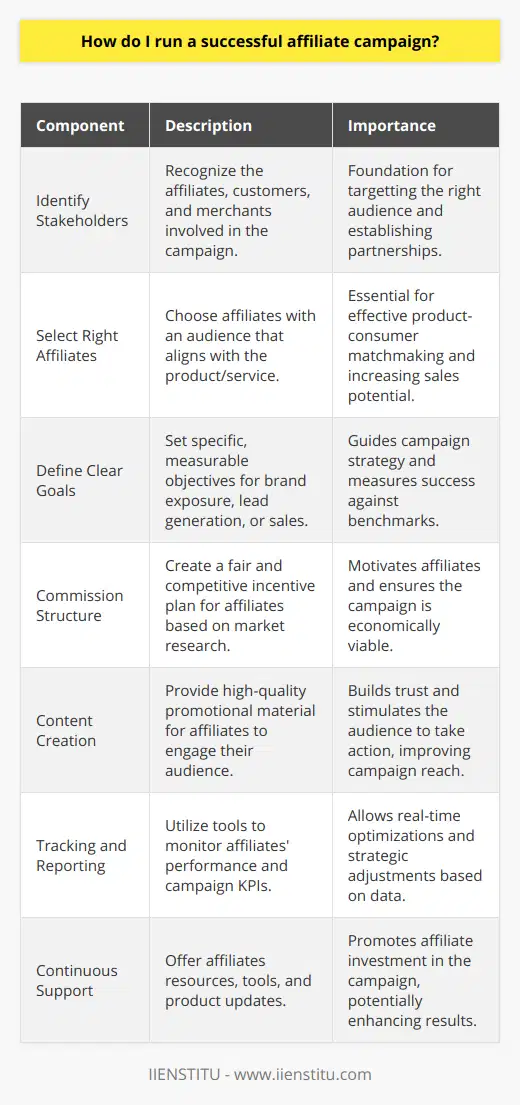
What are the key factors to consider when launching an affiliate marketing product?
Product Selection and Target Audience
When launching an affiliate marketing product, one key factor to consider is selecting a product with high demand and low market saturation. This can be achieved by conducting market research, analyzing trends, and evaluating competition within the niche. Additionally, identifying a specific target audience and tailoring the marketing approach to suit their preferences will ensure that the product resonates with the intended consumers.
Commission Structures and Affiliate Partners
Another important factor is the commission structure offered to affiliate partners as it influences their motivation to promote the product. Attractive commission rates, coupled with consistent payouts, will encourage affiliates to maximize their efforts. Additionally, identifying and partnering with well-established affiliates who have a strong online presence and similar target audiences can enhance the effectiveness of promotional efforts, thereby driving higher conversions and sales.
Marketing Materials and Communication
Providing effective marketing materials is essential to support affiliates in promoting the product. This includes offering promotional tools such as banners, email templates, and product images that affiliates can use on their platforms. Ensuring that these materials are professionally designed and tailored to the target audience can significantly improve engagement and conversion rates.
Moreover, maintaining clear and consistent communication with affiliate partners will help foster strong working relationships. By sharing updates, tips, and best practices, affiliates will feel supported and empowered to succeed in their promotional efforts.
Tracking and Analytics
Implementing well-organized tracking systems is crucial to monitor the performance of affiliates and measure the success of marketing campaigns. By analyzing data such as clicks, conversions, and referral traffic, both the product owner and affiliates can identify opportunities for optimization and address any issues that could hinder the achievement of desired results.
Additionally, employing advanced analytics tools and software can help determine which marketing channels and strategies are most effective, enabling affiliates to fine-tune their campaigns for maximum results.
Ongoing Optimization and Improvement
Lastly, continuously assessing and optimizing marketing efforts is necessary to ensure long-term success in affiliate marketing. By staying informed about emerging trends, technological advancements, and consumer preferences, both the product owner and affiliates can adapt and refine their strategies to maintain relevance and effectiveness in the ever-evolving digital landscape.
In conclusion, the key factors to consider when launching an affiliate marketing product are product selection and target audience, commission structure, marketing materials, tracking and analytics, and ongoing optimization. By addressing these factors and fostering strong partnerships with affiliates, it is possible to achieve success in the competitive world of affiliate marketing.
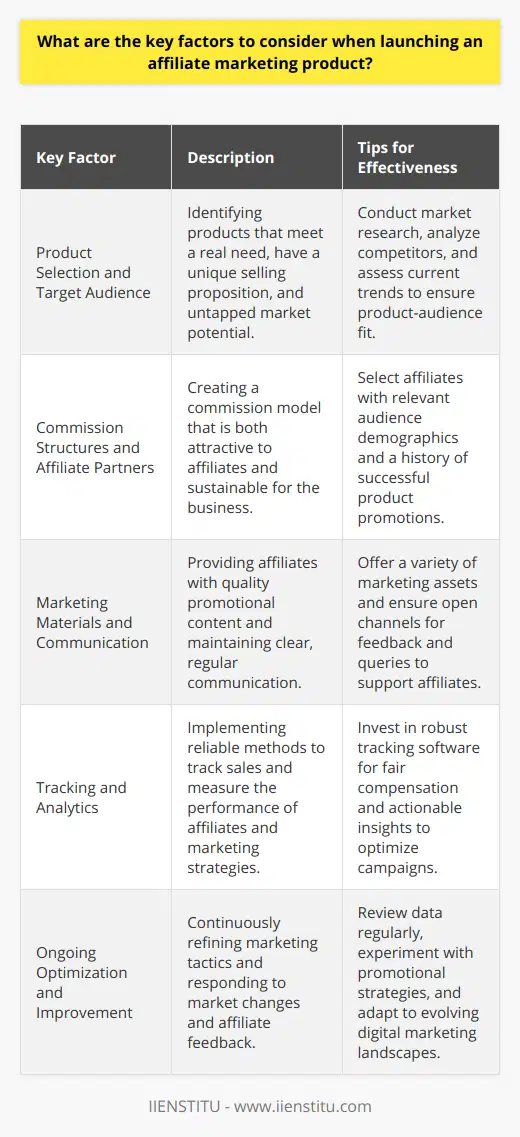
How can I effectively grow and engage my affiliate marketing audience?
Understanding Your Target Audience
Firstly, to effectively grow and engage an affiliate marketing audience, identifying and understanding the target audience is essential. Explore their preferences, pain points, and desires, and use those insights to generate relevant content. Tailoring the content to cater to your target audience's individual needs can not only expand your readership but also increase the probability of them becoming loyal followers and buyers.
Creating High-Quality and Relevant Content
Secondly, producing high-quality, informative, and engaging content is the key to affiliate marketing success. The content should be audience-centric, providing value to your readers and helping them solve problems. Incorporating thorough research and using visual aids like images and videos can further enhance content quality and audience engagement.
Leveraging Multiple Marketing Channels
To grow an affiliate marketing audience efficiently, it is necessary to adopt a multi-channel marketing approach. Utilizing various platforms like social media, email marketing, and paid promotions can help reach a broader audience while also providing opportunities for personalized interactions. Expanding your presence on diverse channels can attract a wider audience and foster deeper relationships with potential customers.
Collaboration and Guest Posting
Collaborating with industry influencers and guest posting on popular blogs can significantly aid in widening your affiliate marketing audience. These collaborations can expose your content to new readers, create valuable backlinks, and establish you as an expert in your niche. Furthermore, this outreach helps increase your blog's credibility and drive more traffic to your site.
Employing SEO Techniques
Finally, implementing effective search engine optimization (SEO) techniques can drive organic traffic to your blog and expand your affiliate marketing audience. Conducting keyword research, optimizing meta tags, improving site speed, and interlinking can enhance user experience and search engine rankings. Consistently publishing SEO-optimized content can lead to steady growth in your affiliate marketing audience over time.
In conclusion, understanding your target audience, creating high-quality and relevant content, utilizing multiple marketing channels, collaborating with industry influencers, and employing SEO techniques can collectively contribute to effectively growing and engaging your affiliate marketing audience. By focusing on these strategies, blog owners can create an outreach that keeps their readers engaged, leading to increased trust, loyalty, and sales.

How can I diversify my affiliate marketing revenue streams while adhering to industry best practices?
Utilizing Multiple Marketing Channels
To diversify affiliate marketing revenue streams while adhering to industry best practices, it is essential to utilize multiple marketing channels. This approach broadens the audience reach, ensuring consistent and stable revenue generation.
Exploring Various Affiliate Programs
Affiliate programs offer a wide array of products, services, and commission structures. Research and join programs that align with your niche and have a strong conversion rate. This way, you rely on multiple income sources rather than a single one.
Building a Solid Email List
A robust email list allows targeted outreach to a highly engaged audience. By effectively nurturing and segmenting this list, you can promote tailored affiliate products that cater to specific audience interests, thus improving conversion rates.
Expanding Content Types and Platforms
Diversification can also be achieved by expanding content types and platforms used to promote affiliate products. These may include blog posts, podcasts, webinars, videos, and social media posts. Leveraging various content types allows for wider audience engagement, and consequently, increased conversions.
Adhering to Industry Best Practices
While diversifying revenue streams, it is crucial to adhere to industry best practices to maintain audience trust and credibility. These best practices include the following:
Disclosure and transparency: Always disclose affiliate relationships and provide honest reviews to maintain transparency with the audience.
Producing valuable content: It is vital to prioritize audience needs by providing valuable and relevant content which educates or entertains, rather than simply promoting products.
Continual iteration and growth: Stay updated on industry trends, new marketing strategies, and performance metrics to optimize your affiliate marketing efforts continuously.
Focus on user experience: Ensuring a positive user experience on your platforms is crucial, as this builds trust with the audience and enhances the likelihood of conversions.
In conclusion, diversifying affiliate marketing revenue streams while adhering to industry best practices involves exploring various affiliate programs, utilizing multiple marketing channels, and expanding content types and platforms. Moreover, adhering to best practices like maintaining transparency, providing valuable content, and prioritizing user experience is essential for long-term success.
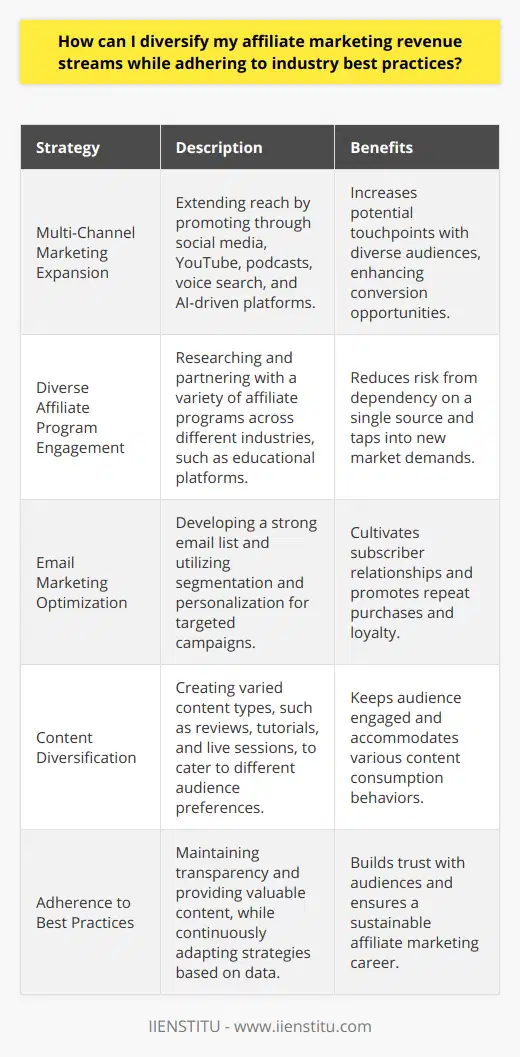
What are the most effective techniques for nurturing and retaining high-performing affiliates in a competitive landscape?
**Understanding High-Performing Affiliates**
To nurture and retain high-performing affiliates in a competitive landscape, it is essential to understand their motivations, preferences, and goals as well as acknowledging their significant contributions to the business. These insights will guide the development of strategies to cater to their unique needs, resulting in increased engagement and satisfaction.
**Tailored Compensation and Incentives**
Implementing a competitive and tailored compensation structure is crucial in retaining high-performing affiliates. By offering incentives such as performance-based bonuses, exclusive rewards, and higher commission tiers, high-performing affiliates will be encouraged to maintain or even surpass their current levels of performance. In addition, it signals the company's commitment to recognizing and rewarding outstanding contributions.
**Effective Communication and Support**
Regular and open communication with high-performing affiliates is essential in understanding their needs and ensuring they receive the necessary support. Providing dedicated account managers, prompt responses to inquiries, and access to exclusive resources demonstrates the company's commitment to strengthening their relationships with these valuable partners. Further, the provision of regular feedback and recognition for their achievements boosts their morale and fosters a sense of belonging.
**Ongoing Training and Development Opportunities**
Providing high-performing affiliates with ongoing training and development opportunities is an effective technique for nurturing and retaining them. Such opportunities may include webinars, workshops, and exclusive access to educational materials, allowing affiliates to stay informed about industry trends and continually enhance their skills. This not only benefits the individual affiliates but also the overall performance and success of the business.
**Flexible Partnership Models**
High-performing affiliates appreciate flexibility in partnership models to meet their specific needs and preferences. By offering various partnership models based on diverse commission structures, promotional materials, and tools, the company can attract and retain affiliates who can drive growth and bring value to the business.
In conclusion, nurturing and retaining high-performing affiliates in a competitive landscape require the implementation of tailored compensation schemes, effective communication and support, continuous training and development opportunities, and flexible partnership models. These strategies form an attractive environment that motivates high-performing affiliates, resulting in increased engagement, satisfaction, and ultimately, the long-term success of the business.
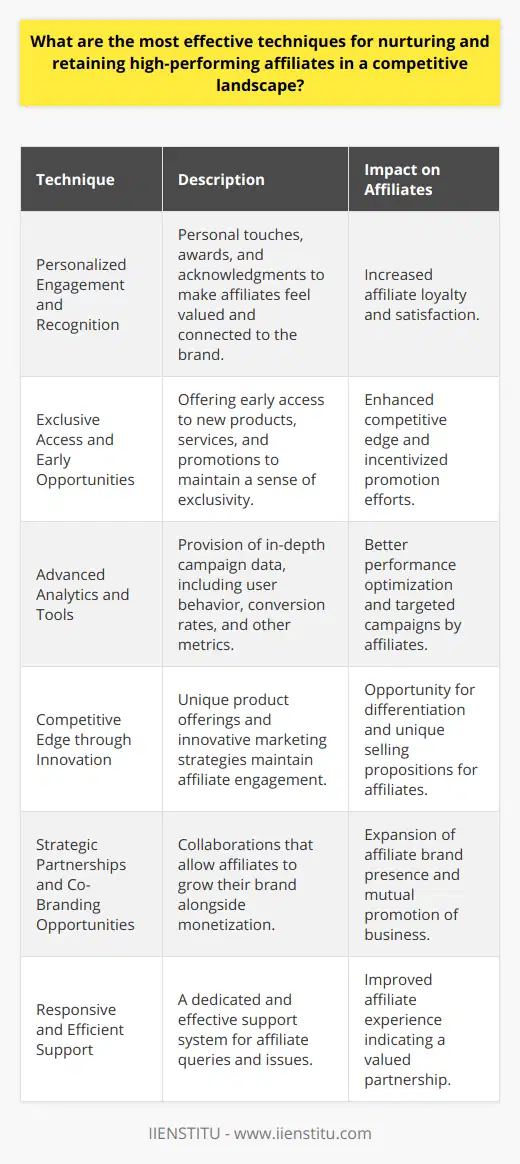
How can I leverage advancements in affiliate marketing software and technology to enhance the efficiency and effectiveness of my campaigns?
Utilizing Innovative Marketing Software Solutions
In order to enhance the efficiency and effectiveness of affiliate marketing campaigns, it is essential to leverage advancements in software and technology. A key aspect for this is selecting innovative marketing software solutions that offer a wide range of tailored features for affiliate program management. Incorporating such tools not only optimizes the time spent on various tasks but also improves the monitoring and analysis of campaign performance.
Embracing Automation and Artificial Intelligence
Embracing automation and artificial intelligence (AI) in affiliate marketing software is another way to maximize campaign efficiency. Automating time-consuming processes, such as link tracking and data analysis, reduces the manual workload and allows for swift adjustments to marketing strategies. AI integration enables higher precision in identifying trends, predicting consumer behavior and analyzing competitors, which results in data-driven decision-making and improved campaign outcomes.
Adopting Personalization Strategies
Personalization has become an influential factor in modern marketing approaches. Utilizing advancements in customer data analysis and management within affiliate marketing software enables the development of highly targeted campaigns. By segmenting the audience based on demographics, preferences, and behavioral patterns, marketers can create tailored content, offers, and promotions that resonate with potential customers on a deeper level, leading to higher engagement and conversion rates.
Integrating Cross-channel Marketing
Cross-channel marketing is another essential aspect to consider while leveraging technology in affiliate campaigns. Ensuring seamless integration of various marketing channels, such as email, social media, and websites, can amplify the campaign reach and effectiveness. Affiliate marketing software with cross-channel functionality allows for efficient management of multiple platforms while maintaining a consistent brand image and messaging, ultimately boosting the campaign's overall performance.
Taking Advantage of Data Analytics
Lastly, harnessing the power of data analytics is crucial for evaluating the efficiency and effectiveness of affiliate marketing campaigns. Advancements in data analysis technology and software solutions enable marketers to gain in-depth insights into the performance of their campaigns. By tracking essential metrics, such as conversion rates, click-through rates, and ROI, marketers can identify areas of improvement and make informed decisions on optimizing their strategies.
In conclusion, leveraging advancements in affiliate marketing software and technology is vital for enhancing the efficiency and effectiveness of campaigns. By embracing innovative software solutions, automation, AI, personalization, cross-channel integration, and data analytics, marketers can ensure the success of their affiliate programs and, ultimately, generate higher revenues.
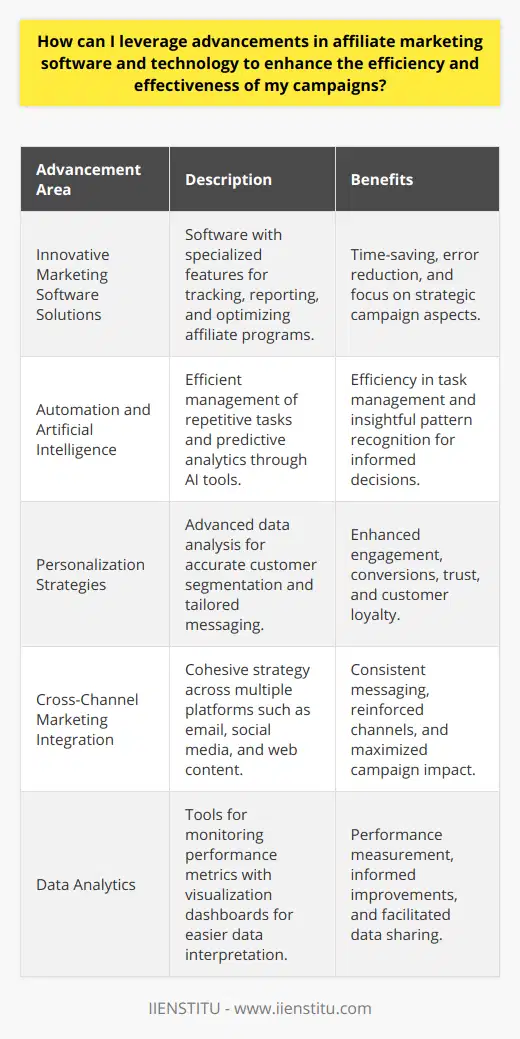
How do I set up an affiliate marketing campaign with a focus on long-term growth and sustainability?
Establishing a Long-Term Strategy
In order to set up an affiliate marketing campaign with emphasis on long-term growth and sustainability, it is imperative to follow specific steps. Firstly, a comprehensive marketing plan should be designed, encompassing well-defined goals, target audiences, and performance metrics. These measures will provide guidance, allowing the campaign to effectively adapt to changing conditions.
Selecting Suitable Affiliate Partners
Identifying and partnering with relevant affiliates is crucial; choosing individuals or platforms that are closely aligned with the products and services being promoted will ensure that the efforts are focused on a suitable audience, thereby increasing the likelihood of long-term success. Additionally, maintaining open communication and nurturing these partnerships can lead to fruitful collaborations and contribute to sustained growth.
Creating High-Quality Content
Producing engaging content is instrumental in driving long-term growth in affiliate marketing. Developing informative blog posts, articles, e-books, and other valuable resources helps establish credibility and fosters trust among readers. Consistently creating such content can not only attract new users but also encourage repeat visits, ultimately increasing the likelihood of users clicking on affiliate links and generating income for the campaign.
Optimizing for SEO
Incorporating search engine optimization (SEO) techniques within the marketing campaign bolsters the visibility of content, making it more accessible to potential consumers. By employing relevant keywords, improving site-load speed, and implementing responsive design, it becomes easier for search engines to rank the content higher on search results pages. Consequently, this strategy will attract more organic traffic, leading to stable, long-term growth.
Monitoring and Analyzing Progress
Regularly analyzing campaign data and assessing progress towards the defined goals allows for a better understanding of the campaign's performance. This data-driven insight enables marketers to identify areas of improvement and adapt their strategy accordingly. By consistently refining and optimizing the campaign, marketers can ensure that it remains relevant and effective, thereby achieving sustained growth and lasting success.
In summary, establishing a long-term affiliate marketing campaign requires a well-defined strategy, partnerships with relevant affiliates, high-quality content creation, SEO optimization, and consistent evaluation of progress. Each of these steps contributes to the overall goal of fostering long-term growth and sustainability within the competitive landscape of affiliate marketing.
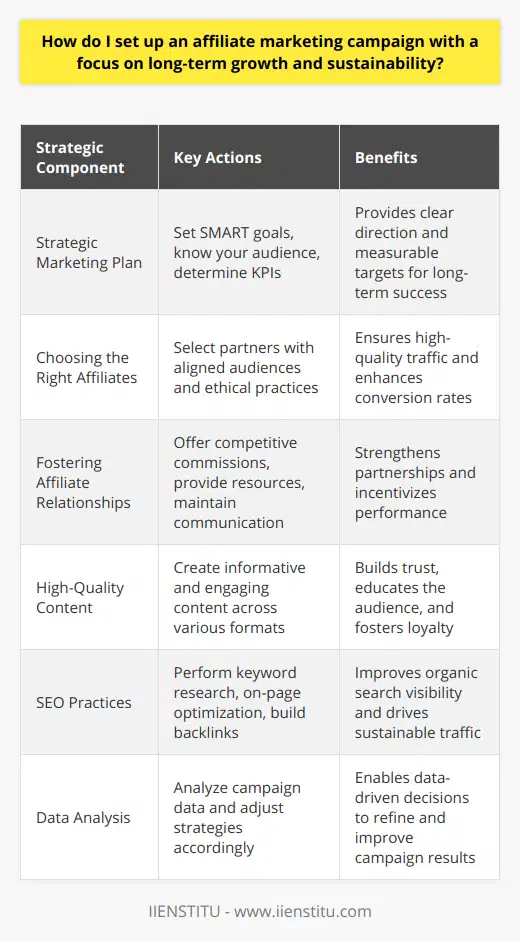
What are some best practices for attracting and retaining high-quality affiliates for a successful marketing campaign?
Attracting High-Quality Affiliates
One of the best practices for attracting high-quality affiliates is to offer a competitive commission structure. By providing lucrative rewards, companies can entice proficient marketers to choose their program over competitors. Additionally, offering attractive incentives, such as bonuses and exclusive promotions, can also contribute to the appeal of the affiliate program.
Maintaining Clear Communication
Effective communication plays a significant role in retaining high-quality affiliates. Providing them with regular updates on products, sales tools, and promotional materials can create a sense of trust and collaboration. Furthermore, establishing a seamless support system for affiliates, where they can address their concerns or seek assistance, can directly impact their satisfaction and commitment to the program.
Supplying Marketing Tools
Providing affiliates with marketing tools such as ready-to-use graphics, banners, and promotional content can significantly improve their campaign performance. By offering these resources, companies can ensure brand consistency, optimized messaging, and targeted marketing. This, in turn, attracts successful affiliates who value these resources and helps retain their loyalty over time.
Monitoring and Tracking Performance
To retain high-quality affiliates, it is essential to monitor their performance and provide feedback. Companies need to offer a comprehensive and user-friendly tracking system to quickly assess the success of various marketing campaigns. Recognizing and rewarding top-performing affiliates can guarantee their continued dedication to your program, leading to greater overall success.
Continuous Training and Education
Many high-quality affiliates are looking for opportunities to grow and develop their marketing skills. By offering continuous training and education resources, companies can keep affiliates updated on the latest marketing strategies, industry trends, and product developments. This approach not only retains high-quality affiliates but also enhances their marketing efforts to boost the overall campaign success.
In conclusion, attracting and retaining high-quality affiliates for a successful marketing campaign requires a mix of strategies focusing on lucrative rewards, effective communication, marketing tools, performance monitoring, and continuous training. By incorporating these best practices, companies can build a robust network of committed affiliates, leading to the success of their marketing campaigns.

How can I utilize data-driven strategies and the latest affiliate marketing tools to optimize my campaign performance and achieve desired outcomes?
Understanding the Data-driven Approach
A data-driven approach allows marketers to make informed decisions based on historical data and current trends. As a crucial component of affiliate marketing, it helps in understanding consumer behavior and knowing what resonates with the target audience. Utilizing various data-driven strategies can thus optimize campaign performance and ensure desired outcomes.
Leveraging Analytical Tools
Implementing analytical tools, such as Google Analytics and Adobe Analytics, offers insights into user behavior and specific metrics. By understanding these metrics, marketers can make better decisions on what content and marketing strategies to use. Moreover, these tools help track conversion rates and analyze the effectiveness of marketing tactics.
Adopting Automation and Personalization
To continually enhance campaigns, implementing automation and personalization is vital. Marketing automation tools, such as Marketo and HubSpot, streamline marketing processes while improving efficiency. A personalized approach, on the other hand, tailors marketing messages and offers to each individual customer using data points like browsing history, purchasing patterns, and demographics. Personalization ensures a more focused and relevant marketing experience for consumers, ultimately leading to increased conversion rates.
Focusing on Customer Retention
Affiliate marketing is not just about acquiring new customers but also retaining existing ones. With a data-driven strategy, marketers can identify customers with higher lifetime value (LTV) and work towards retaining and nurturing them. Loyalty programs and personalized offers encourage repeat purchases and increase long-term revenue.
Testing and Optimizing Campaigns
It is essential to test campaign elements continually and optimize them based on the data collected. A/B testing, also known as split testing, is a method of comparing different versions of a campaign to determine the most effective variation. By running tests on creatives, landing pages, and marketing messages, marketers can learn what works best for their audience and make necessary adjustments.
Monitoring and Adapting to Market Trends
Affiliate marketing tools enable marketers to monitor market trends and competitor strategies. By staying informed on the latest industry developments, marketers can modify their campaigns to align with the prevailing best practices. Constantly adapting to the ever-changing market conditions will ensure the campaign's effectiveness, helping achieve desired goals.
In conclusion, leveraging data-driven strategies and efficient affiliate marketing tools can significantly optimize campaign performance. Analyzing metrics, adopting automation and personalization, focusing on customer retention, and continually testing and adapting to market trends will enable marketers to drive successful campaigns and achieve their desired outcomes in the long run.
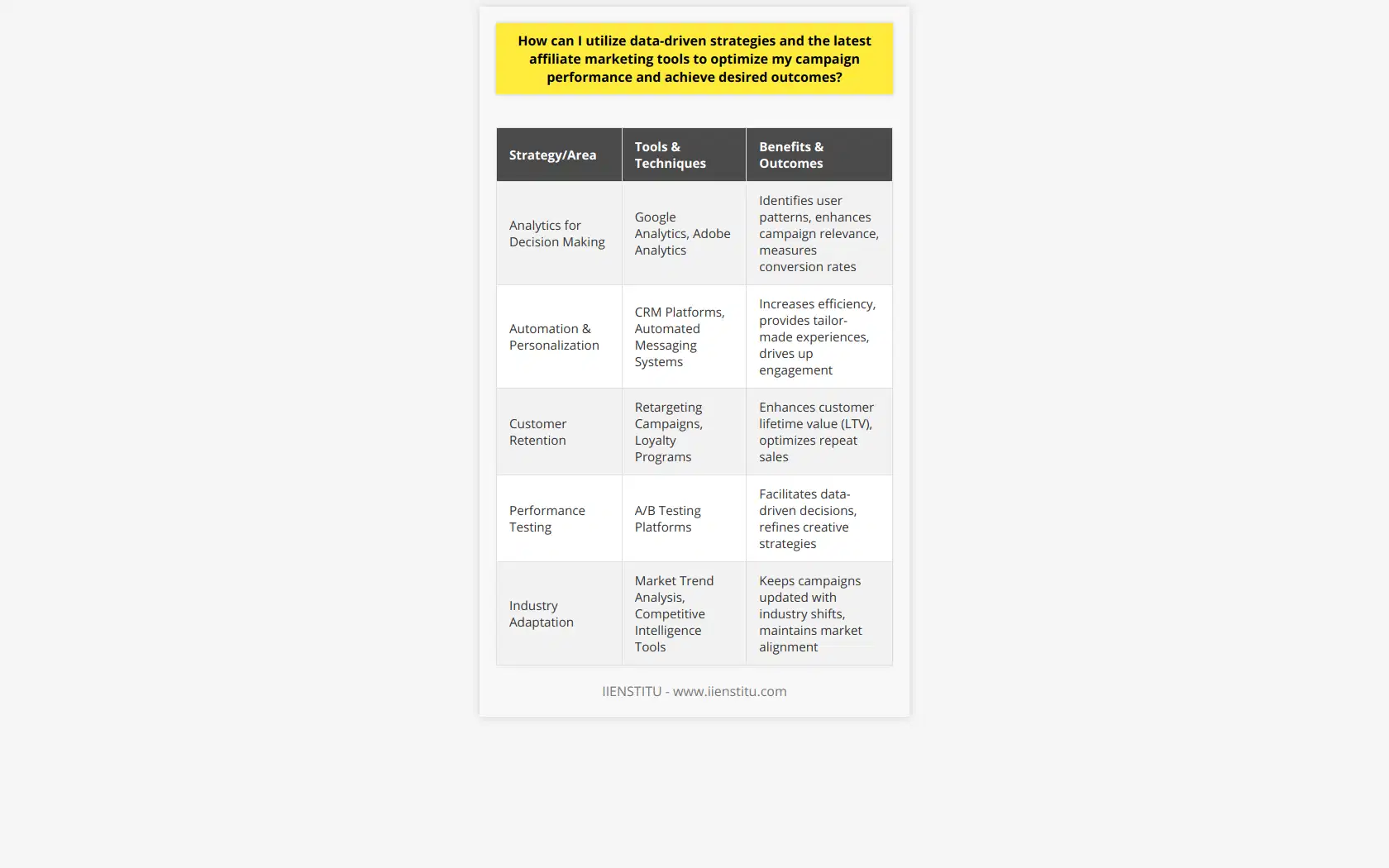
How do I make my affiliate marketing successful by identifying and partnering with the most relevant and high-quality affiliates?
Understanding Affiliate Marketing
To ensure success in affiliate marketing, it is crucial to comprehend its basic concepts, which primarily involve partnering with affiliates who promote your products or services through their online platforms, driving traffic and generating sales leads, while earning a commission in return.
Selecting High-Quality Affiliates
The foremost aspect of achieving success lies in identifying and partnering with high-quality affiliates who possess established online presence, reputation, and credibility. To achieve this goal, monitor their website quality, engagement levels, and audience demographics to determine their suitability for endorsing your products or services.
Affiliate Management Tools
Make use of affiliate management tools that are widely available, such as HasOffers, Post Affiliate Pro, and ReferralCandy, to streamline the process of tracking clicks, conversions, and commissions, while gaining insights on the performance of your affiliates. These tools allow performance-based evaluations to identify your most valuable partnerships.
Joining Affiliate Networks
Affiliate networks play a vital role in having access to a diverse pool of potential affiliates. By joining established and reliable networks like CJ Affiliate, ShareASale, and Rakuten Marketing, you can leverage their partnership opportunities and connect with relevant affiliates to promote your offerings.
Negotiating Commission Structures
A fair and competitive commission structure is essential to attract high-quality affiliates. Be flexible in negotiating the structure and offer incentives, such as performance bonuses and tiered plans, based on their ability to drive sales and generate leads. By rewarding top-performing affiliates on the level of their contribution, you foster loyalty and commitment to your brand.
Offering Marketing Materials
To make your partnership fruitful, provide affiliates with an array of marketing materials, including product images, promotional banners, and ad copies, to assist them in seamlessly integrating your offerings into their content. This will help ensure a consistent brand image and message, while facilitating audience engagement.
Measuring Performance
Regularly measure and evaluate the performance of your affiliates through key performance indicators (KPIs) such as clicks, conversions, and return on investment (ROI). By analyzing the data, you can identify areas for improvement and evolve your affiliate marketing strategies to optimize success.
In conclusion, identifying and partnering with the best affiliates is a continuous process that can bolster your affiliate marketing success. By implementing the aforementioned strategies—understanding the core aspects, choosing high-quality affiliates, employing management tools, joining networks, negotiating commission structures, providing marketing materials, and measuring performance—you can cultivate mutually beneficial partnerships and achieve the desired outcomes.
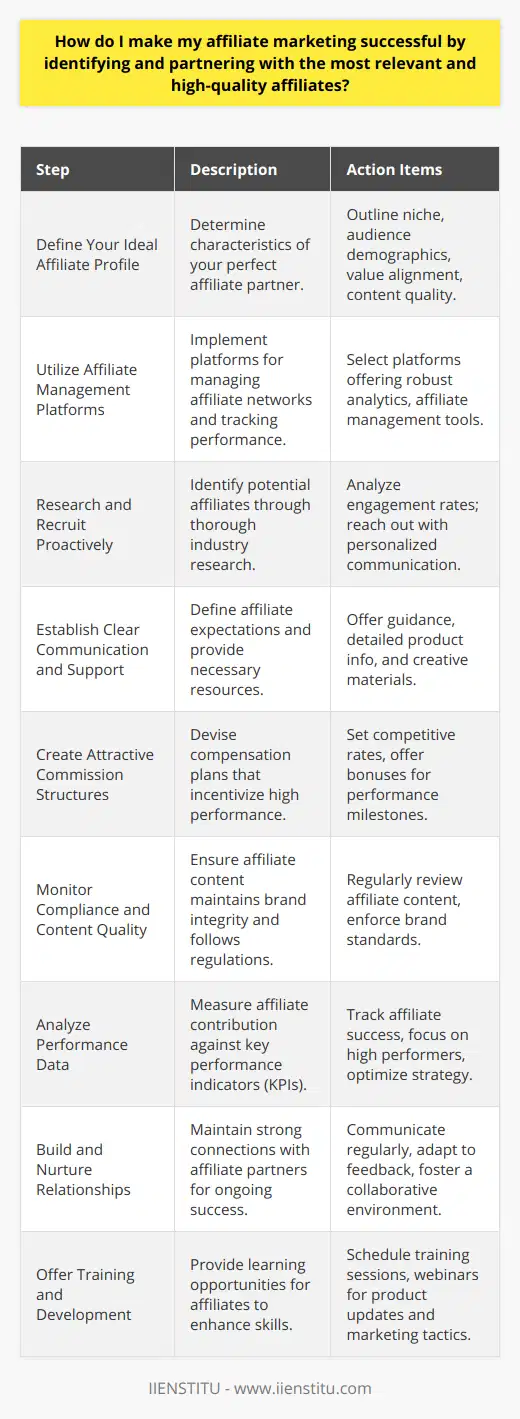
What marketing strategies should be employed to effectively target and engage the desired audience for affiliate marketing campaigns?
Identifying the Target Audience
To create effective marketing strategies for affiliate marketing campaigns, it is crucial to begin by accurately identifying the target audience. The desired audience can be segmented based on various criteria such as demographics, interests, and online behavior. By conducting thorough market research, it becomes possible to create a detailed profile of the target consumer that allows for more precise marketing efforts.
Utilizing Appropriate Channels
Once the target audience is identified, the next step is to choose the most suitable marketing channels for reaching that audience. Common online marketing channels include social media platforms, search engines, and email newsletters. While utilizing various channels, it is important to analyze the performance of each channel in driving engagement and sales, and adjusting the strategy accordingly.
Content Marketing
Content marketing plays a significant role in successfully engaging the target audience for affiliate marketing campaigns. The creation of high-quality, value-driven content tailored to the audience's needs and interests is essential. Integrating affiliate products or services smoothly within that content establishes credibility and trust, ultimately driving conversions.
Social Media Marketing
The use of social media platforms such as Facebook, Instagram, and Twitter can amplify the reach of affiliate marketing campaigns. Engaging in sponsored posts, influencer collaborations, and paid advertising can drive traffic to the content promoting affiliate products. Additionally, being active and responsive on these platforms aids in fostering connections with the target audience.
Email Marketing
Another effective marketing strategy is leveraging email marketing to maintain a direct line of communication with the audience. By building a list of subscribers, marketers can regularly share relevant news, offers, and curated content to retain their audience’s interest. Keeping email communication personalized, informative, and engaging will encourage clicking on affiliate links, leading to increased conversions.
Search Engine Optimization (SEO)
Lastly, incorporating search engine optimization (SEO) tactics can enhance the visibility of content containing affiliate links. By optimizing content, one can target high-intent keywords related to affiliate offers, ensuring that it ranks well in search engine results pages (SERPs). This increases the probability of driving organic traffic to the content, thereby improving the chances of converting users into customers.
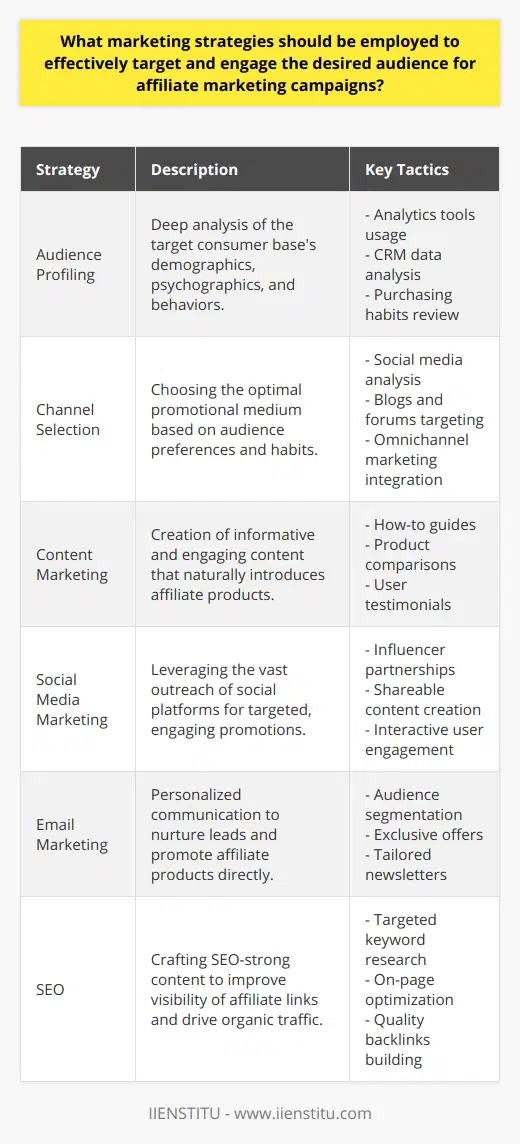
How can I consistently evaluate and refine my affiliate marketing efforts to maximize revenue generation and ensure ongoing success in an ever-changing digital landscape?
Establish Clear Objectives
To consistently evaluate and refine your affiliate marketing efforts, it is crucial to establish clear objectives. These can help measure progress and provide a basis for adjusting strategies. Goals should be specific, measurable, achievable, relevant, and time-bound (SMART) to facilitate effective assessment and improvement.
Analyze Key Performance Indicators (KPIs)
Key Performance Indicators (KPIs) are quantifiable metrics that demonstrate the effectiveness of your affiliate marketing efforts. Identifying relevant KPIs enables you to assess which aspects of your marketing strategy are working well and where there is room for improvement. Examples of common KPIs include conversion rates, customer acquisition costs, and average order value.
Leverage Analytics Tools
Using analytics tools, such as Google Analytics or specialized affiliate tracking systems, provides valuable insights into your marketing performance. These tools facilitate tracking of KPIs, identification of traffic sources, and monitoring of user behavior. Analyzing this data allows you to optimize your marketing strategies and capitalize on successful channels and tactics.
Test and Optimize Creatives
Regularly testing and optimizing your creative assets, such as banners and ad copy, ensures that your promotional materials remain engaging and relevant. A/B testing enables data-driven decisions by comparing the performance of different variations of your creatives. This process helps identify the most effective combinations of visuals and copy, maximizing your chances of driving conversions.
Stay Informed on Industry Trends
The digital landscape is constantly evolving, requiring you to stay informed on the latest trends in affiliate marketing to maintain a competitive edge. Regularly consuming industry-related content, attending webinars, and participating in conferences ensures that you are up-to-date on new strategies, best practices, and emerging platforms. This knowledge can help you adapt your marketing efforts and capitalize on new opportunities.
Evaluate Partner Performance
Periodically evaluating the performance of your affiliate partners ensures that your marketing efforts are aligned with your goals. This includes assessing the quality of leads generated, the volume of traffic driven, and compliance with the terms and conditions of your affiliate program. By working closely with high-performing partners and addressing underperformance, you can maximize revenue generation and maintain a successful program.
In summary
Consistent evaluation and refinement of your affiliate marketing efforts is critical in maximizing revenue generation and achieving ongoing success in the digital landscape. Establishing clear objectives, leveraging analytics tools, testing creatives, staying informed on industry trends, and evaluating partner performance are essential steps in this continuous improvement process.
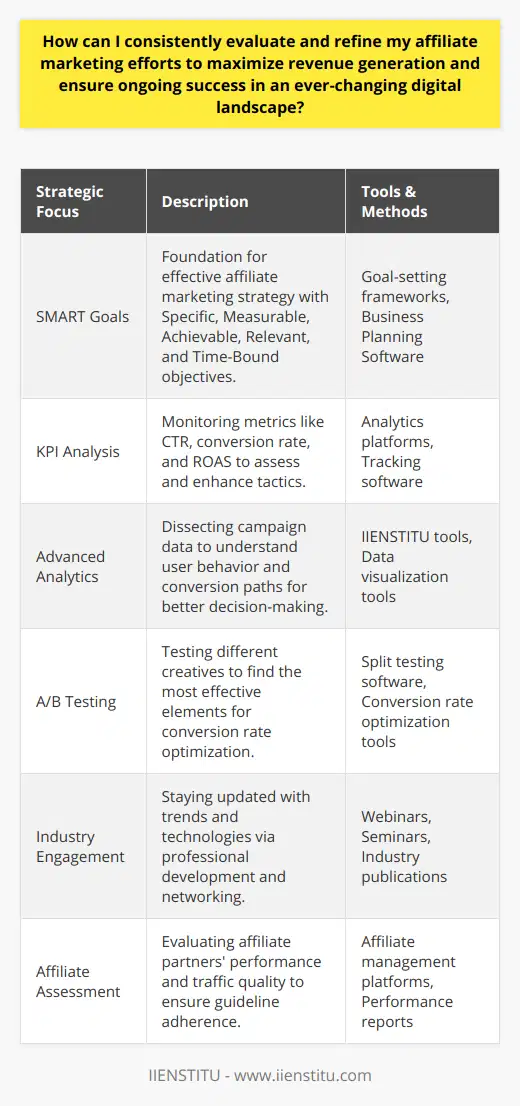
What is the best target audience for affiliate marketing?
Ideal Target for Affiliate Marketing
Defining a 'best' target audience for affiliate marketing isn't straightforward. The primary reason is that ideal groups widely vary based on the promoted products, services, or platforms. Despite this, some general trends can help identify potential target audiences for affiliate marketing.
Marketing to Digital Natives
Digital natives, typically younger generations like Millennials and Generation Z, often become the main focus of affiliate marketing. Their frequent online presence makes them accessible targets. These demographics are comfortable with making an online purchase, increasing the potential for successful marketing. They also tend to have a significant influence on trends in consumer behavior.
Chasing Niche Audiences
Niche audiences often provide high potential for affiliate marketing. These individuals show a deep interest in a specific topic, hobby, or industry. They actively seek information and products related to their interests. Affiliate marketers can leverage this by providing reviews, comparison articles, or integrated products or services experiences.
B2B (Business-to-Business) Audience
A growing area of focus is the B2B audience. As businesses increasingly transition online, offering affiliate products or services that meet their professional needs can be lucrative. It provides an opportunity to target professionals who make purchase decisions for their organizations.
Women as a Target Group
Finally, women represent a diverse and potent target group. Many affiliate marketing strategies concentrate on sectors traditionally dominated by female consumers like fashion, beauty, and home goods. However, it's critical to avoid stereotyping and provide a product range and content that reflects modern gender roles.
In conclusion, the 'best' target audience depends on many factors like the product nature and the affiliate marketer's content strategy. However, digital natives, niche audiences, B2B audiences, and women often offer valuable opportunities for affiliate marketing.
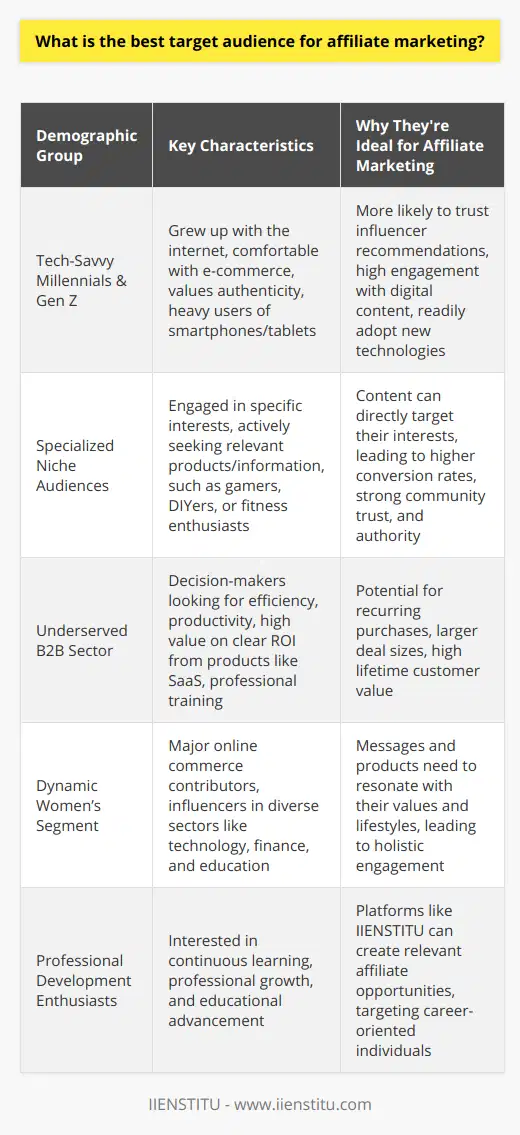
How do I start an affiliate marketing campaign that aligns with both my brand's goals and the interests of potential affiliates?
Identifying Mutual Interests
To initiate an affiliate marketing campaign that aligns with your brand's goals and the interests of potential affiliates, you first need to identify mutual interests. This identification entails a thorough understanding of your brand's core values, products, and targeted audience. Recognize what potential affiliates could gain from partnering with your brand.
Establishing Campaign Objectives
Secondly, set tangible and measurable campaign objectives. These goals connect directly with your brand's broader strategic aims. The objectives must resonate with potential affiliates and should include concrete rewards that motivate them.
Selecting the Right Affiliates
Choose the right affiliates; those who have similar target audiences as yours. Research if their online presence aligns with your brand image. Their influence and credibility will directly impact your brand's reputation.
Crafting an Effective Message
Ensure that your campaign's message communicates what your brand offers, and the benefits an affiliate gains from promoting your product. The message must be concise, persuasive, and consistent.
Building Affiliate Relationships
Relationship building forms an integral part of the success of your campaign. Prioritize open communication, transparency, and mutual respect. Affiliates should feel valued, recognized, and rewarded for their efforts, thus fostering long-term collaboration.
Providing Required Tools
Supply necessary tools and resources to your affiliates. These may include marketing materials, tracking systems, and training. Ease of usage and effective implementation are crucial for the success of your campaign.
Tracking and Evaluation
In conclusion, you need to track and evaluate your campaign's performance regularly. Use various metrics, like click-through rates or conversion rates. The collected data will help you refine your campaign and ensure its alignment with your brand goals and the interests of your affiliates.
Incorporating these strategies will ensure a successful affiliate marketing campaign that aligns with your brand's endeavors and piques the interest of potential affiliates.
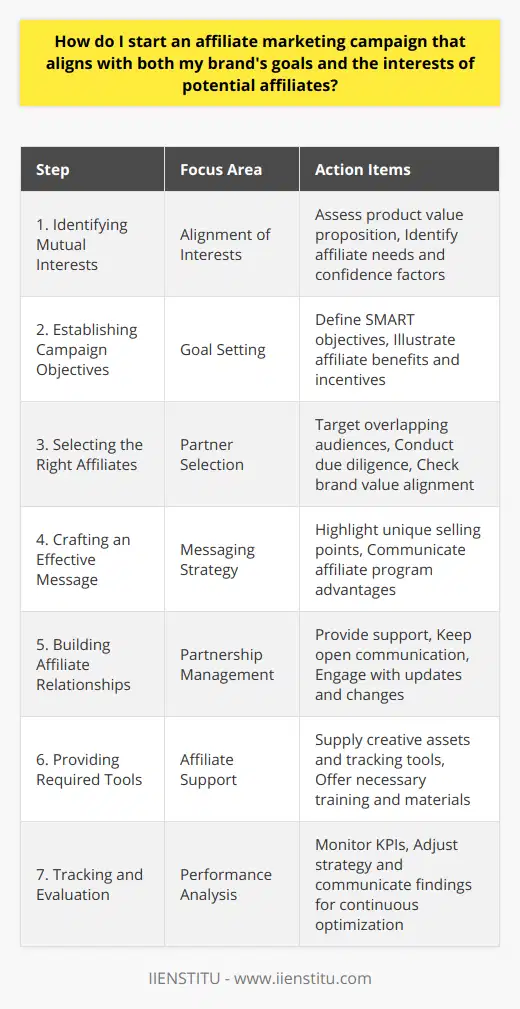
How can I ensure a steady growth in my affiliate marketing audience while maintaining campaign performance and profitability?
Optimizing Content Strategies
To ensure steady growth in an affiliate marketing audience, focus on optimizing content strategies. High-quality, relevant content invites readers and promotes engagement.
Understanding the Audience
Understanding your audience's interests and needs is vital in shaping the marketing content. Harmonize your content to resonate with their expectations. This drives increased traffic and fosters audience growth.
Effective SEO Techniques
Deploying efficient SEO techniques can enhance the visibility of your blog posts. Use appropriate keywords and stay updated with current SEO trends to rank high on search engine result pages. This promotes organic traffic to your site.
Engaging Call-to-Action
Incorporating an effective call-to-action (CTA) in your blog post can boost performance. This encourages audience interaction and promotes leads which can convert into tangible profits.
Consistent Posting Schedule
Maintaining a consistent posting schedule is vital. Regular updates keep audiences engaged, ensuring their continuous interest in your blog.
Data Analytics
Becoming proficient in data analytics is necessary to gauge campaign performance. Use analytic tools to gauge audience response and adjust strategy accordingly.
Affiliate Program Promotions
Promote your affiliate program actively and openly. Communicate how it benefits your audience and why they should participate. This will foster an attitude of participation and increase audience rates.
Strategic Use of Social Media Platforms
Leverage social media platforms strategically to promote your blog. Engage with followers consistently to build a strong community and enhance brand visibility.
Continuous Learning and Improvisation
The digital marketing landscape continually evolves. Keep abreast of trends and technologies to stay competitive. Continuous learning and improvisation are the keys to maintaining campaign performance and profitability.
